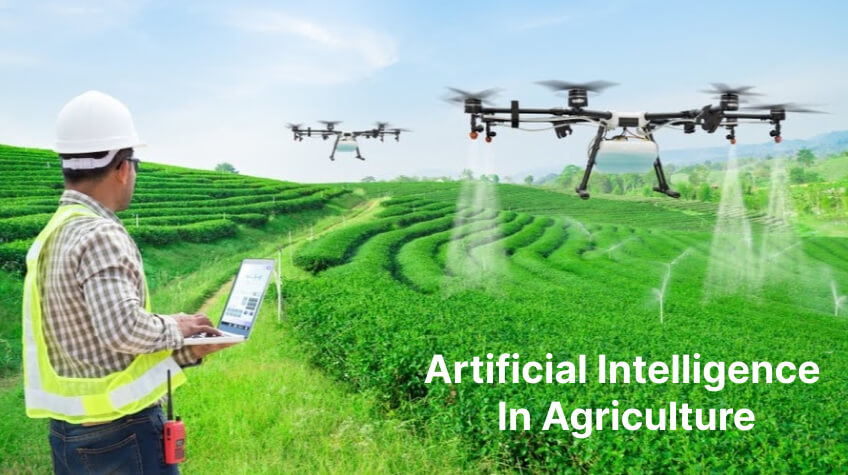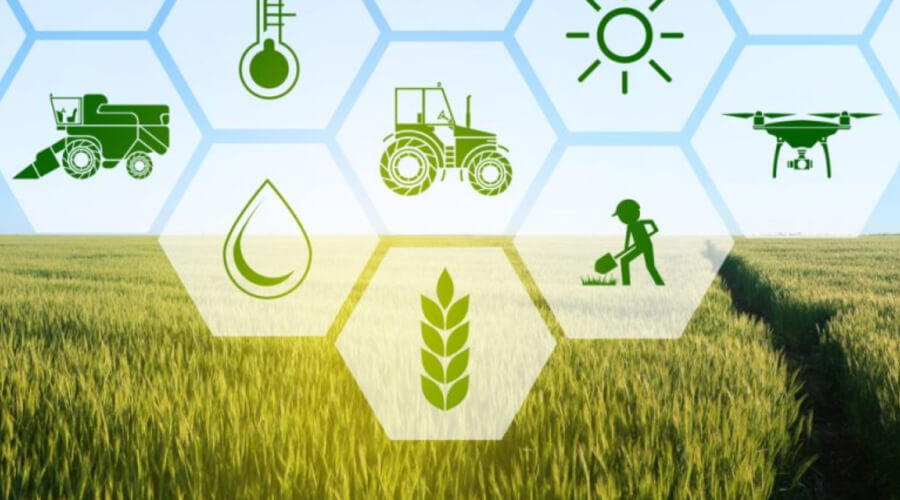
Globalization and modernization have put pressure on agriculture, making conventional farming practices unable to meet the increasing food demand and efficiently tackle climate change-related challenges. Modern technologies have become the ultimate ally that drove agricultural digitalization and led to the birth of precision (or smart) AI in agriculture. Artificial intelligence (AI), which is ubiquitous now, has grown to become an essential part of agriculture that advances the progress of its sustainable transformation.
Innovative AI-based solutions help farmers do more and better with less, maximizing crop productivity with fewer inputs. AI drives food sector transformation by optimizing field activities, including planting and harvesting, and enabling better management and planning, which in its turn leads to efficient utilization of depleting natural resources. There are several agricultural areas where AI is currently booming: robotics, crop and soil monitoring, and predictive analysis. These technologies can forecast issues and deliver much-needed solutions that will help mitigate the global food and water crisis.
Remote sensing and satellite imagery: AI in Agriculture
The value of AI in agriculture is in leveraging big data that has become widely accessible with the latest advances in satellite and remote sensing technologies. Remote sensing analysis helps crop growers make sense of the satellite imagery and gain insights into crop and field conditions that enable multiple applications, especially when combined with AI techniques. One of them, machine learning (ML), offers powerful technology for analyzing a wealth of remotely sensed data on fields for crop yield prediction and estimation, crop classification, weed and disease detection, crop loss assessment, plant count, drought and water stress identification, and more.
The spaceborne data captured by satellites is advantageous to other data types due to global coverage and solid archives of historical Earth observations. The historical imagery is key to understanding trends in farming activities and plant productivity. The human mind can hardly process such amounts of data, while AI techniques can easily digest it and identify hidden patterns. And when you know past and current trends, you can try to predict what will come next, for example, forecasting crop yield through the use of a machine learning algorithm.
How ML and neural networks leverage satellite data for the Benefit of Agriculture
Machine learning is a technology that enables computers’ ability to learn: machines analyze input data and make the best decision possible. In terms of modern farming, this translates into less manual work and greater efficiency in all aspects of field management. Unlike traditional agriculture, ML-driven solutions take into account multiple factors. For example, to achieve higher accuracy, machine learning for the prediction of crop yield considers various datasets on top of crop production data, such as soil health, rainfall and temperature, seed variety, fertilizer use, etc. Crop yield is influenced by lots of variables (climate, land type, resource availability), and the more critical determinants are included in predictive analysis, the smaller the error.

One of the most essential elements of AI and machine learning is artificial neural networks (ANNs). They mimic the human brain structure and contain neurons – mathematical functions collecting and classifying data based on a specific architecture. Being the main alternative to classical math models, artificial neural networks often prove useful in prediction and classification tasks. The range of neural network applications with AI in agriculture is very wide, including forecasting crop yield, disease and pest verification, classification of harvested crops, evaluation of crop variety suitability, intelligent weed control, and intelligent irrigation control.
The power of artificial neural networks (ANNs) lies in the ability to explore the non-linear relationship between the data, unlike normal statistics. As we know, agricultural output is highly dependent on weather variables, such as temperature, precipitation, humidity, and so on. Given climate change, weather is more unpredictable than ever. In terms of analysis, it means that weather data is characterized by complex nonlinear relationships and this is where the neural networks technology comes in, being able to self-train and make forecasts with a high level of accuracy.
Once machines present the results of their calculations, people can act on them: for a farmer, prediction of crop yield in their fields can become a guide to deciding on what crops and when to grow; for a government, crop yield prediction at a regional or national level can help estimate food availability and take immediate action to reduce the famine risks.
However, machines can make decisions on their own. Limited arable lands and water scarcity is pushing people to find ways for smarter, more sustainable resource use. Intelligent irrigation systems are a viable solution that uses machine learning models to identify crops lacking moisture and AI to activate water supply equipment and water dry field areas. Intelligent fertilizer and pesticide systems act similarly: whenever a nutrient deficiency or pest infestation is detected, the machine would apply the required amount of fertilizer or pesticide to the field site. Some AI-driven solutions go beyond and include the prediction of various agro-climatic parameters to increase the efficiency of intelligent irrigation or AI in agriculture.
Thanks to major advances in artificial intelligence and the rapid accumulation of agricultural data sourced from satellites, UAVs, or in-situ sensors, crop growers can accurately quantify vegetation data at any scale and process big data, turning it into valuable predictions and recommendations. The methods of AI in agriculture leverage vast amounts of crop, field, and weather information and enable informed decision-making in all farming aspects. They have become an ally in tackling global challenges, such as climate change, natural resources abuse, and food crisis, which affect agriculture, and now help find solutions that will make agriculture productive, cost-efficient, and sustainable.






